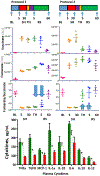Red Blood Cell Metabolic Responses to Torpor and Arousal in the Hibernator Arctic Ground Squirrel
- PMID: 30793910
- PMCID: PMC7219541
- DOI: 10.1021/acs.jproteome.9b00018
Red Blood Cell Metabolic Responses to Torpor and Arousal in the Hibernator Arctic Ground Squirrel
Abstract
Arctic ground squirrels provide a unique model to investigate metabolic responses to hibernation in mammals. During winter months these rodents are exposed to severe hypothermia, prolonged fasting, and hypoxemia. In the light of their role in oxygen transport/off-loading and owing to the absence of nuclei and organelles (and thus de novo protein synthesis capacity), mature red blood cells have evolved metabolic programs to counteract physiological or pathological hypoxemia. However, red blood cell metabolism in hibernation has not yet been investigated. Here we employed targeted and untargeted metabolomics approaches to investigate erythrocyte metabolism during entrance to torpor to arousal, with a high resolution of the intermediate time points. We report that torpor and arousal promote metabolism through glycolysis and pentose phosphate pathway, respectively, consistent with previous models of oxygen-dependent metabolic modulation in mature erythrocytes. Erythrocytes from hibernating squirrels showed up to 100-fold lower levels of biomarkers of reperfusion injury, such as the pro-inflammatory dicarboxylate succinate. Altered tryptophan metabolism during torpor was here correlated to the accumulation of potentially neurotoxic catabolites kynurenine, quinolinate, and picolinate. Arousal was accompanied by alterations of sulfur metabolism, including sudden spikes in a metabolite putatively identified as thiorphan (level 1 confidence)-a potent inhibitor of several metalloproteases that play a crucial role in nociception and inflammatory complication to reperfusion secondary to ischemia or hemorrhage. Preliminary studies in rats showed that intravenous injection of thiorphan prior to resuscitation mitigates metabolic and cytokine markers of reperfusion injury, etiological contributors to inflammatory complications after shock.
Keywords: sulfur; tryptophan metabolism; untargeted metabolomics.
Conflict of interest statement
Notes
The authors declare no competing financial interest.
Figures







Similar articles
-
Controllable oxidative stress and tissue specificity in major tissues during the torpor-arousal cycle in hibernating Daurian ground squirrels.Open Biol. 2018 Oct 10;8(10):180068. doi: 10.1098/rsob.180068. Open Biol. 2018. PMID: 30305429 Free PMC article.
-
Analysis of microRNA expression during the torpor-arousal cycle of a mammalian hibernator, the 13-lined ground squirrel.Physiol Genomics. 2016 Jun;48(6):388-96. doi: 10.1152/physiolgenomics.00005.2016. Epub 2016 Apr 15. Physiol Genomics. 2016. PMID: 27084747 Free PMC article.
-
Arousal from Torpor Increases Oxidative Damage in the Hibernating Thirteen-Lined Ground Squirrel (Ictidomys tridecemlineatus).Physiol Biochem Zool. 2022 May-Jun;95(3):229-238. doi: 10.1086/719931. Physiol Biochem Zool. 2022. PMID: 35443147
-
How the gut and liver hibernate.Comp Biochem Physiol A Mol Integr Physiol. 2021 Mar;253:110875. doi: 10.1016/j.cbpa.2020.110875. Epub 2020 Dec 25. Comp Biochem Physiol A Mol Integr Physiol. 2021. PMID: 33348019 Free PMC article. Review.
-
Mitochondrial Metabolism in Hibernation: Regulation and Implications.Physiology (Bethesda). 2022 Sep 1;37(5):0. doi: 10.1152/physiol.00006.2022. Epub 2022 Jun 6. Physiology (Bethesda). 2022. PMID: 35658625 Review.
Cited by
-
Cytoprotection by a naturally occurring variant of ATP5G1 in Arctic ground squirrel neural progenitor cells.Elife. 2020 Oct 14;9:e55578. doi: 10.7554/eLife.55578. Elife. 2020. PMID: 33050999 Free PMC article.
-
The influence of a human macronutrient-matched diet on phenotypes in old mice.Geroscience. 2025 Apr;47(2):2293-2308. doi: 10.1007/s11357-024-01423-6. Epub 2024 Nov 8. Geroscience. 2025. PMID: 39514173 Free PMC article.
-
Metformin reduces the competitive advantage of Dnmt3aR878H HSPCs.Nature. 2025 Jun;642(8067):421-430. doi: 10.1038/s41586-025-08871-w. Epub 2025 Apr 16. Nature. 2025. PMID: 40240595
-
Glutathionylation chemistry promotes interleukin-1 beta-mediated glycolytic reprogramming and pro-inflammatory signaling in lung epithelial cells.FASEB J. 2021 May;35(5):e21525. doi: 10.1096/fj.202002687RR. FASEB J. 2021. PMID: 33817836 Free PMC article.
-
Interactions between host genetics and gut microbiota determine susceptibility to CNS autoimmunity.Proc Natl Acad Sci U S A. 2020 Nov 3;117(44):27516-27527. doi: 10.1073/pnas.2002817117. Epub 2020 Oct 19. Proc Natl Acad Sci U S A. 2020. PMID: 33077601 Free PMC article.
References
-
- Carey HV; Andrews MT; Martin SL Mammalian Hibernation: Cellular and Molecular Responses to Depressed Metabolism and Low Temperature. Physiol. Rev 2003, 83 (4), 1153–1181. - PubMed
-
- Williams DR; Epperson LE; Li W; Hughes MA; Taylor R; Rogers J; Martin SL; Cossins AR; Gracey AY Seasonally Hibernating Phenotype Assessed through Transcript Screening. Physiol. Genomics 2006, 24 (1), 13–22. - PubMed
Publication types
MeSH terms
Substances
Grants and funding
LinkOut - more resources
Full Text Sources
Other Literature Sources

